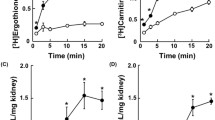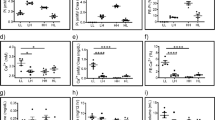Abstract
In order to study the specificity of the contraluminal para-aminohippurate (PAH) transport system, the inhibitory potency of monocarboxylates on the3H-PAH influx from the interstitium into cortical tubular cells in situ has been determined. The following was found: if a homologous series of fatty acids with increasing chain length is tested, inhibition of contraluminal PAH influx is first seen with valerate (app.K i 1.4 mmol/l), increasing up to nonanoate (app.K i 0.06 mmol/l) and remaining in this range up to duodecanoate, the last compound of this series which is sufficiently water-soluble. Similarly, the inhibitory potency of aromatic monocarboxylates increases with increasing hydrophobicity. If the fatty acids are esterified, their inhibitory potency is lost. If they are transformed to the respective aldehydes their inhibitory potency is preserved at a reduced degree. Introduction of a hydrophobic methyl-, ethyl-, or propyl-group increases the inhibitory potency. A β-, but not an α-oxo-group augments the inhibitory potency of phenylpropionate analogs, an OH group diminishes it, and a NH2 group abolishes it. Among phenyl-fatty acids an increase in affinity is observed from phenyl- < benzoylamine-< phenoxy- < benzoyl-acetate and-propionate. All monocarboxylate compounds, so far tested, do not inhibit contraluminal sulfate and Na+/succinate influx. The data indicate that the PAH transporter interacts with monocarboxylates and also with aldehydes which have a hydrophobic moiety. An additional oxo-group facilitates the interaction. Thus, the benzoyl compounds show the highest affinity observed.
Similar content being viewed by others
References
Barác-Nieto M (1971) Renal uptake of para-aminohippuric acid. In vitro effects of palmitate andl-canitine. Biochim Biophys Acta 233:446–452
Beyer KH, Baer JE, Michaelson JK, Russo HF (1965) Renotropic characteristics of ethacrynic acid in a phenoxyacetic saluretic-diuretic agent. J Pharmacol Exp Ther 147:1–22
Cross RJ, Taggart JV (1950) Renal tubular transport: accumulation of PAH by rabbit kidney slices. Am J Physiol 161:181–190
Despopoulos A (1965) A definition of substrate specificity in renal transport of organic anions. J Theor Biol 8:163–192
Erne K, Sperber I (1974) Renal tubular transfer of phenoxyacetic acids in the chicken. Acta Pharmacol Toxicol 35: 233–241
Farah A, Frazer M, Stoffel M (1963) Studies on the run out of p-aminohippurate acid from renal slices. J Pharmacol Exp Ther 139:120–128
Fritzsch G, Haase W, Rumrich G, Fasold H, Ullrich KJ (1984) A stopped flow capillary perfusion method to evaluate contraluminal transport parameters of methylsuccinate from interstitium into renal proximal tubular cells. Pflügers Arch 400:250–256
Hansch C, Leo A, Unger SH, Kim KH, Nikaitani D, Lien EJ (1973) “Aromatic” substituent constants for structure-activity correlations. J Med Chem 16:1207–1216.
Knoefel PK, Huang KC (1956) The biochemorphology of renal tubular transport of iodinated benzoic acids. J Pharmacol Exp Ther 117:307–316
Maxild J (1971) Role of fatty acid metabolism on renal transport of para-aminohippurate in vitro. Biochim Biophys Acta 233:434–445
Pritchard JB, Bend JR (1984) Mechanisms controlling the renal excretion of xenobiotics in fish: effects of chemical structure. Drug Metab Rev 15:655–671
Sheikh MI, Stahl M (1977) Characteristics of accumulation of probenecid by rabbit kidney cortical slices. Am J Physiol 232:F513-F523
Trimble ME (1979) Transport and metabolism of octanoate by the perfused rat kidney. Am J Physiol 237:F210-F217
Ullrich KJ, Papavassiliou F (1986) Contraluminal transport of small aliphatic carboxylates in the proximal tubule of the rat kidney in situ. Pflügers Arch 407:488–492
Ullrich KJ, Rumrich G, Klöss S (1984) Contraluminal sulfate transport in the proximal tubule of the rat kidney. I. Kinetics, effects of K+, Na+, Ca2+, H+ and anions. Pflügers Arch 402:264–271
Ullrich KJ, Rumrich G, Fasold H, Zaki L (1986) Affinity labels as substrates for the three partially overlapping anion transport systems at the contraluminal cell side of the renal proximal tubule. J Clin Chem Clin Biochem 24:684
Ullrich KJ, Rumrich G, Fritzsch G, Klöss S (1987) Contraluminal para-aminohippurate (PAH) transport in the proximal tubule of the rat kidney. II. Specificity: Aliphatic dicarboxylic acids. Pflügers Arch 408:38–45
Ullrich KJ, Rumrich G, Fritzsch G (1987) Contraluminal para-aminohippurate transport in the proximal tubule of the rat kidney. I. Kinetics, influence of cations, anions and capillary preperfusion. Pflügers Arch 409:229–235
Weiner IM, Blanchard KC, Mudge GH (1964) Factors influencing renal excretion of foreign organic acids. Am J Physiol 207:953–963
Author information
Authors and Affiliations
Rights and permissions
About this article
Cite this article
Ullrich, K.J., Rumrich, G. & Klöss, S. Contraluminal para-aminohippurate transport in the proximal tubule of the rat kidney. Pflugers Arch. 409, 547–554 (1987). https://doi.org/10.1007/BF00584652
Received:
Accepted:
Issue Date:
DOI: https://doi.org/10.1007/BF00584652




